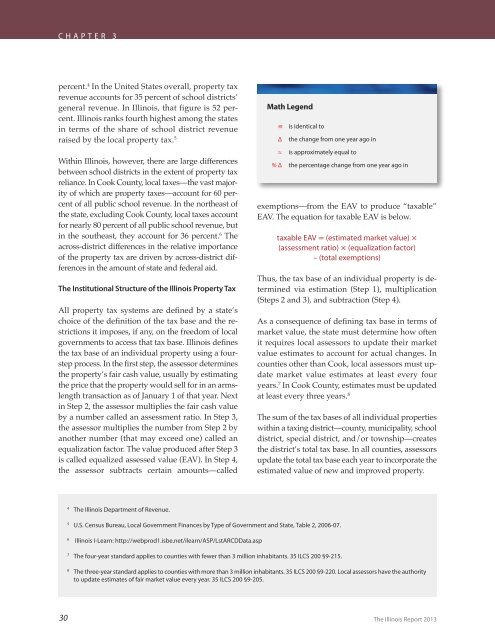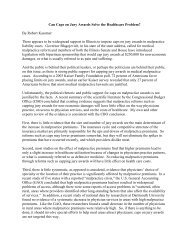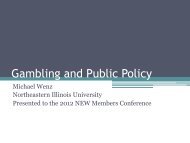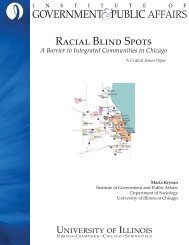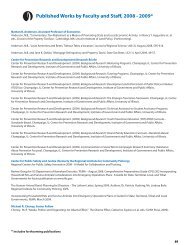The Illinois Report 2013 - Institute of Government & Public Affairs ...
The Illinois Report 2013 - Institute of Government & Public Affairs ...
The Illinois Report 2013 - Institute of Government & Public Affairs ...
You also want an ePaper? Increase the reach of your titles
YUMPU automatically turns print PDFs into web optimized ePapers that Google loves.
C H A P T E R 3<br />
percent. 4 In the United States overall, property tax<br />
revenue accounts for 35 percent <strong>of</strong> school districts’<br />
general revenue. In <strong>Illinois</strong>, that figure is 52 percent.<br />
<strong>Illinois</strong> ranks fourth highest among the states<br />
in terms <strong>of</strong> the share <strong>of</strong> school district revenue<br />
raised by the local property tax. 5<br />
Within <strong>Illinois</strong>, however, there are large differences<br />
between school districts in the extent <strong>of</strong> property tax<br />
reliance. In Cook County, local taxes—the vast majority<br />
<strong>of</strong> which are property taxes—account for 60 percent<br />
<strong>of</strong> all public school revenue. In the northeast <strong>of</strong><br />
the state, excluding Cook County, local taxes account<br />
for nearly 80 percent <strong>of</strong> all public school revenue, but<br />
in the southeast, they account for 36 percent. 6 <strong>The</strong><br />
across-district differences in the relative importance<br />
<strong>of</strong> the property tax are driven by across-district differences<br />
in the amount <strong>of</strong> state and federal aid.<br />
<strong>The</strong> Institutional Structure <strong>of</strong> the <strong>Illinois</strong> Property Tax<br />
All property tax systems are defined by a state’s<br />
choice <strong>of</strong> the definition <strong>of</strong> the tax base and the restrictions<br />
it imposes, if any, on the freedom <strong>of</strong> local<br />
governments to access that tax base. <strong>Illinois</strong> defines<br />
the tax base <strong>of</strong> an individual property using a fourstep<br />
process. In the first step, the assessor determines<br />
the property’s fair cash value, usually by estimating<br />
the price that the property would sell for in an armslength<br />
transaction as <strong>of</strong> January 1 <strong>of</strong> that year. Next<br />
in Step 2, the assessor multiplies the fair cash value<br />
by a number called an assessment ratio. In Step 3,<br />
the assessor multiplies the number from Step 2 by<br />
another number (that may exceed one) called an<br />
equalization factor. <strong>The</strong> value produced after Step 3<br />
is called equalized assessed value (EAV). In Step 4,<br />
the assessor subtracts certain amounts—called<br />
Math Legend<br />
≡<br />
Δ<br />
≈<br />
is identical to<br />
the change from one year ago in<br />
is approximately equal to<br />
% Δ the percentage change from one year ago in<br />
exemptions—from the EAV to produce “taxable”<br />
EAV. <strong>The</strong> equation for taxable EAV is below.<br />
taxable EAV = (estimated market value) ×<br />
(assessment ratio) × (equalization factor)<br />
– (total exemptions)<br />
Thus, the tax base <strong>of</strong> an individual property is determined<br />
via estimation (Step 1), multiplication<br />
(Steps 2 and 3), and subtraction (Step 4).<br />
As a consequence <strong>of</strong> defining tax base in terms <strong>of</strong><br />
market value, the state must determine how <strong>of</strong>ten<br />
it requires local assessors to update their market<br />
value estimates to account for actual changes. In<br />
counties other than Cook, local assessors must update<br />
market value estimates at least every four<br />
years. 7 In Cook County, estimates must be updated<br />
at least every three years. 8<br />
<strong>The</strong> sum <strong>of</strong> the tax bases <strong>of</strong> all individual properties<br />
within a taxing district—county, municipality, school<br />
district, special district, and/or township—creates<br />
the district’s total tax base. In all counties, assessors<br />
update the total tax base each year to incorporate the<br />
estimated value <strong>of</strong> new and improved property.<br />
4<br />
<strong>The</strong> <strong>Illinois</strong> Department <strong>of</strong> Revenue.<br />
5<br />
U.S. Census Bureau, Local <strong>Government</strong> Finances by Type <strong>of</strong> <strong>Government</strong> and State, Table 2, 2006-07.<br />
6<br />
<strong>Illinois</strong> I-Learn: http://webprod1.isbe.net/ilearn/ASP/LstARCDData.asp<br />
7<br />
<strong>The</strong> four-year standard applies to counties with fewer than 3 million inhabitants. 35 ILCS 200 §9-215.<br />
8<br />
<strong>The</strong> three-year standard applies to counties with more than 3 million inhabitants. 35 ILCS 200 §9-220. Local assessors have the authority<br />
to update estimates <strong>of</strong> fair market value every year. 35 ILCS 200 §9-205.<br />
30<br />
<strong>The</strong> <strong>Illinois</strong> <strong>Report</strong> <strong>2013</strong>


